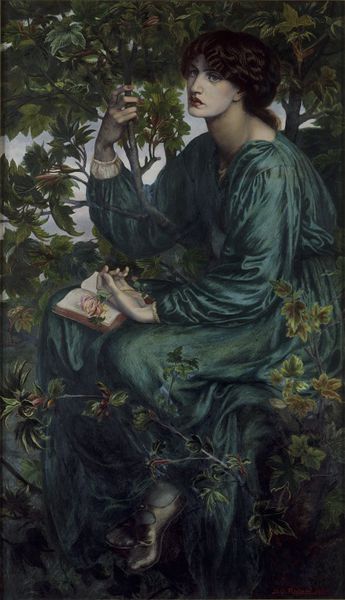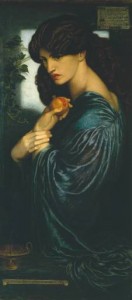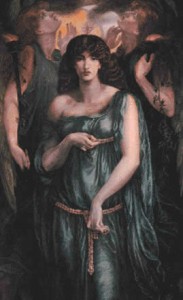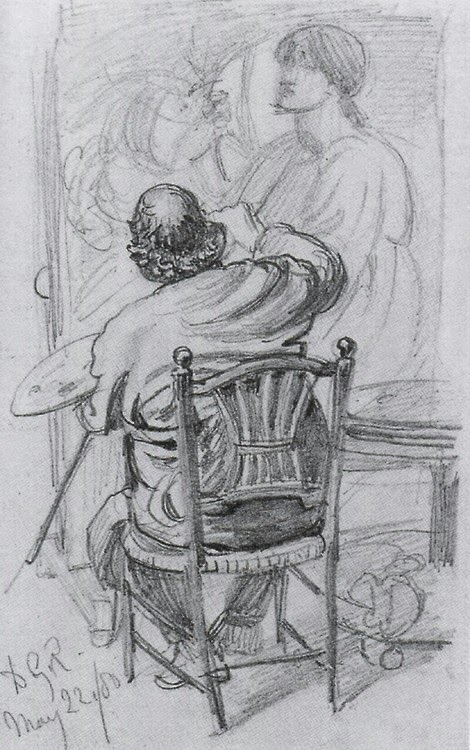One of Dante Gabriel Rossetti’s last paintings shows Jane Morris in a world of green. She’s surrounded by foliage, seemingly lost in a day dream while her book lies ignored on her lap. Her hand loosely holds a honeysuckle.



Jane is clad in a similar dress to the one she wore in Proserpine, where she is again seen both wearing and surrounded by green. Another green garment can also be seen in Astarte Syriaca, although it is more loosely draped and her bare shoulders are exposed.
Rossetti wrote a sonnet to accompany The Day Dream (read here in full). The poem ends She dreams ; till now on her forgotten book/Drops the forgotten blossom from her hand. The poem and picture are obviously about the woman lost in her day dream, but Rossetti’s obsessive use of Jane Morris in his paintings makes me question whether or not the title refers to Jane as the subject of his own daily thoughts and dreams. Perhaps the painting is not of a woman day dreaming, but showing us the fixation of the artist’s own day dream. To paraphrase his sister Christina Rossetti’s poem, perhaps we see Jane here not as she is, but as she fills his dream. (In an Artists’s Studio).
In the study for The Day Dream, we can focus on Jane’s face. This is the face that captivated Rossetti from the moment he spotted her in the theatre audience in Oxford, the face that has become representative of Rossetti’s body of work.

“How nice it would be if I could feel sure I had painted you once and for all so as to let the world know what you were, but every new thing I do from you is a disappointment, and it is only at some odd moment when I cannot set about it that I see by a flash the way it ought to be done,” Rossetti wrote to Jane. She was an important part of Rossetti’s later years and each painting can be seen as an attempt to capture some inexplicable quality that is the key to their relationship. Perhaps each work is a different “day dream”, if we look at day dreams as a way to explore our subconscious. This article, What Your Daydreams Reveal About You, discusses day dreams as a way to understand ourselves, set goals and improve our lives. Seen in this psychological context, the title of Rossetti’s painting takes on a deeper meaning. Jane Morris, as Rossetti’s muse, became the catalyst for “day dreams” that inspired some of his greatest masterpieces. Through his work, he may not have been exploring not only Jane’s face, but what she meant to him and why.


Since I’ve discovered The Pre Raphaelite Sisterhood I fell in love with those artists. This site is very useful and very beautiful . Thank you very much. I live in Brazil.
I love all the greens in the paintings of her! It goes well with her dark hair. I have recently really started liking green!
Lovely post, the study with just the head coloured looks wonderful, and I’d never seen the Frederic Shields sketch before, what a great snapshot!
I saw The Day Dream earlier this year at the V&A. I love not knowing exactly where the painting you are searching for is, and then just turning a corner and stumbling upon it, always makes me gasp. It’s even more beautiful in real life, and massive!
Day Dream life full of wonders while on sits in the garden.
The painting grasps the elegance of a woman. Embracing the garden,day dreaming at peace within herself.
Thank you for your patience…. with me when I came unglued….
Hi, good writing. Can you please provide me with another like to the sonnet with the poem Rossetti wrote to accompany the painting?
Thanks,
Dorcas